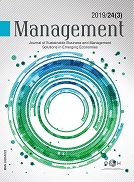Reviewer Guidelines
Purpose of peer review
Peer review is key part in academic research publishing process. Main functions of peer review are:
- Acts as a filter to reject low quality research beyond chance of improvement from publishable paper.
- Increase the quality of the submitted papers through communication of improvement possibilities for the paper.
If you are interested to see how the double-blind review process works and how the reviewers are selected after the initial article screening, please see our detailed swimlande gudeline on screening and review.
Accepting availablity for review
If we have asked you to perform a review, please first check article you are being asked to review truly match your expertise? The Editor who has approached you may not know your work intimately, and may only be aware of your work in a broader context. Only accept an invitation if you have confidence in your competence to review the article.
If you believe that the article is relevant, next consider, do you have time to review it? Reviewing an article can be quite time consuming. The time taken to review can vary from field to field, but on average an article will take 3 hours to review properly. Will you have sufficient time before the deadline stipulated in the invitation to conduct a thorough review? If you can not conduct the review let the editor know immediately, and if possible advise the editor of alternative reviewers, or ask for a longer deadline which is often possible.
Once you have established that the article is in your field of expertise, and you have sufficient time to complete the review, the next item to consider is whether there are any potential conflicts of interest. A conflict of interest will not necessarily eliminate you from reviewing an article, but full disclosure to the editor will allow them to make an informed decision. For example, if you suspect that author is someone who works in the same department or institute, worked on a paper previously with you or have a professional or financial connection to the article -these should all be listed when responding to the editor’s invitation for review.
Conducting the review
Reviewing needs to be conducted confidentially, the article you have been asked to review should not be disclosed to a third party. If you wish to elicit opinion from colleagues or students regarding the article you should let the editor know beforehand, and ask for their further non-disclosure of the article. It is normally not a problem to do so. Most editors welcome additional comments, but whoever else is involved will likewise need to keep the review process confidential. You should not attempt to contact the author.
Be aware when you submit your review that any recommendations or advice you make, will contribute to the final decision which is made by the editor. Set aside two or three hours to conduct the review. It is better to complete the evaluation in one go rather than snatching time here and there.
Depending upon the journal, you will be asked to evaluate the article on a number of criteria. Some journals provide detailed guidance others do not. Normally you would be expected to evaluate the article according to the following:
1.Originality.
Is the article sufficiently novel and interesting to warrant publication? Does it add to the canon of knowledge? Does the article adhere to the journal's standards? Is the research question an important one? In order to determine its originality and appropriateness for the journal it might be helpful to think of the research in terms of which percentile it is in?
2.Structure.
Is the article clearly laid out? Are all the key elements present: abstract, introduction, methodology, results, conclusion? Consider each element in turn:
- Title: does it clearly describe the article?
- Abstract: does it reflect the content of the article?
- Introduction:does it describe what the author hoped to achieve accurately, and clearly state the problem being investigated? Normally, the introduction is one to two paragraphs long. It should summarize relevant research to provide context, and explain what findings of others, if any, are being challenged or extended. It should describe the experiment, hypothesis (es); general experimental design or method.
- Is the methodologyappropriate? Does it accurately explain how the data was collected? Is the design suitable for answering the question posed? Is there sufficient information present for you to replicate the research? Does the article identify the procedures followed? Are these ordered in a meaningful way? If the methods are new, are they explained in detail? Was the sampling appropriate? Have the equipment and materials been adequately described? Does the article make it clear what type of data was recorded; has the author been precise in describing measurements?
- Results:this is where the author/s should explain in words what he/she discovered in the research, any interpretation should not be included in this section. The results should be clearly laid out and in a logical sequence. You will need to consider if the appropriate analysis been conducted. Are the statistics correct? If you are not comfortable with statistics, advise the editor when you submit your report.
- Conclusion/Discussion. Are the claims in this section supported by the results? Do they seem reasonable? Have the authors indicated how the results relate to expectations and to earlier research? Does the article support or contradict previous theories? Does the conclusion explain how the research has moved the body of scientific knowledge forward?
- Figures and tables: On balance, when considering the whole article, do the figures and tables inform the reader, are they an important part of the story? Do the figures describe the data accurately? Are they consistent, e.g. bars in charts are the same width, the scales on the axis are logical
- Language.
If an article is poorly written with a number of misspelt words and grammatical errors, you do not need to correct the English. Advise the editor of the poor quality, and allow them to take appropriate action. Correcting English in a paper is not the role of the reviewer. - Previous Research.
If the article builds upon previous research does it reference that work appropriately? Are there any important works that have been omitted? Are the references accurate?
5. Ethical Issues.
- Plagiarism: if you suspect that an article is a substantial copy of previous work/s, let the editor know. Please cite the previous work/s.
- Fraud: it is very difficult to detect the determined fraudster, but if you suspect that the results in an article to be untrue let the editor know explaining why you believe the results to be fraudulent.
- Other ethical concerns: if there has been violation of accepted norms of ethical treatment of animal or human subjects these should also be identified.
Communicating your report to the editor
Once you have completed your evaluation of the article the next step is to write up your report. If it looks like you might miss your deadline, let the editor know. The report should contain the key elements of your review, addressing the points outlined in the preceding section. When providing commentary you should be courteous and constructive, consider, ‘how would you react to receiving your suggestions’. It should not include any personal remarks.
Providing insight into any deficiencies is important. You should explain and support your judgment so that both editors and authors are better able to understand the basis of the comments. You should indicate whether your comments are your own opinion or reflected by data.
If you think the article needs to be revised indicate to the editor clearly identifying what revision is required and advise whether or not you would be happy to review the revised article. Lot of reviewers provide detailed remarks in the form of comments or track changes in word processor. It is very useful to the authors, and if you can, please do that. Please, also keep in mind that comment should not reveal your identity, e.g. go to options of your text processor and temporarily change your name to “Reviewer”.
The last step is Recommendation. Reviewer makes recommendation using the dropdown menu.
Choices include:
Accept Submission: It is ready to go to Copyediting and Publication as is.
Minor Revision: It requires minor changes that may be reviewed and accepted by the reviewer or by the editor.
Major Revision: It requires major changes and another round of peer review.
Reject: It doesn’t seem like a good fit for the focus and scope of this journal, it has too many weakness to ever be accepted.
Journal editors and publishers are grateful to the reviewers of the 2020th year. Their diligent and professional effort improved the quality of the selection process and published articles.
















